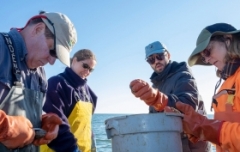Knauss legislative fellowships in Congress help build careers — and they're fun and educational. See our video and fact sheet for details.
No Filter: Growing Concerns Over Sunscreen Chemicals
The active ingredients in sunscreens and some personal care products, a group of chemicals known as UV filters, have been in the eyes of the public and international regulators for their potential toxicity.
UV filters are individual compounds that block ultraviolet light. We use them in sunscreens or personal care products to prevent the sun’s harmful rays from damaging our skin and causing cancer, but some regulators are concerned with their effect on the environment. Hawaii and Key West have banned the sale of two UV filters, oxybenzone and octinoxate, for their potential bleaching effects on coral species. The island nation of Palau went even further, banning ten UV filters including oxybenzone and octinoxate. So, what’s the harm here?
There is a relatively simple, logical assessment of why regulators are concerned about the spread of UV filters in the environment: they absorb sunlight and photosynthetic organisms need sunlight to grow. That means they can harm keystone species, such as algae and submerged aquatic vegetation, which provide food and habitat for other aquatic organisms. UV filters can also pose an endocrine disruption risk; however, no conclusive evidence has demonstrated acute or chronic toxicity in humans.
It comes as no surprise that the regions banning UV filters have these concerns in mind, but why would regulators only ban some, but not all filters? The choice to only ban specific ones corresponded with scientific inquiries conducted in each region, but the new regulations fail to capture the theme of these studies: all UV filters pose a potential threat to photosynthetic organisms. In the end, the politicians and regulators in Hawaii, Key West, and Palau are concerned with protecting the organism that boosts their tourism industry and provides a habitat for numerous aquatic species: coral.
A focus on corals
A study by Downs et al. in 2013 confirmed the toxicity of benzophenone-2, a UV filter similar in structure as oxybenzone, to be detrimental to the larval form of the coral Stylophora pistillata. This study, among many others, helped demonstrate the potential harm of these emerging contaminants towards corals. Corals enjoy a symbiotic relationship with algae. The algae provide the corals with nutrients and oxygen, and the coral provide the algae with protection and carbon dioxide. Both organisms grow and develop in this co-dependent relationship, which is why any disruption to this relationship can prove traumatic for both species. This disturbance is why UV filters are suspected to bleach the algae and ultimately destroy the coral. The argument for protecting corals from the harmful effects of UV filters follows from a few studies and rational assessment, but are these sunscreen ingredients really that toxic?
To answer this question, we must consider other risks to corals, such as climate change, ocean acidification, and physical damage caused by people. Rising global temperatures and ocean acidification deteriorate coral fitness by weakening their shells and disrupting natural functions. This type of damage is generally gradual but has greatly contributed to the chronic decline of coral species. From boats dropping anchor to snorkelers collecting souvenirs, direct human contact with corals has observable, acute effects. Altogether, these impacts need to be diminished; however, these factors are thought to contribute more towards dwindling coral species than UV filter pollution. Nonetheless, the potential for UV filters to compound the impacts from other risks needs careful study.
So how can we protect ourselves from sunburns, yet ensure no harm to aquatic species like corals? Cover up! Most clothing will block the sun’s harmful rays. For example, wetsuits generally provide a sun protection factor of 50 — only 1/50th of the sun’s rays penetrate the clothing and reach your skin. The Food and Drug Administration recommends having an SPF of at least 15, so clothing, like a wetsuit, can easily accomplish this feat. The other benefit to wearing clothing as sun protection is that it is both broad-spectrum and water-resistant, which means that it protects you from all sun radiation and does not need to be reapplied several times throughout the day.
Another option is sunscreen containing non-nanoparticle inorganic UV filters, like titanium or zinc oxide. These UV filters provide the same benefit as their organic counterparts without the same ecotoxicological concerns. Most of the brands that make these sunscreens come from Australia or are promoted to be “reef safe," but to confirm your choice is the most ecologically friendly, you’ll just need to find the active ingredient list and confirm only the presence of the metal oxides in the formula. Although we can be certain that our sunscreen choice is protecting our skin and the corals, it will come at a higher cost: inorganic sunscreens are often twice the price of their organic counterparts. UV filters may pose an ecological risk, but we can easily avert this threat and protect ourselves with conscientious clothing or sunscreen choice.
Photo, top left: Maryland Department of Natural Resources Shellfish Division crew members wear sunscreen with the inorganic UV filter zinc oxide as the active ingredient during oyster surveys to avoid sample contamination. Ethan Hain is the third person from the left. Photo credit: Robert Bussell.
The views in this blog post are those of the author alone and are not recommendations by Maryland Sea Grant or UMBC.
See all posts to the Fellowship Experiences blog

